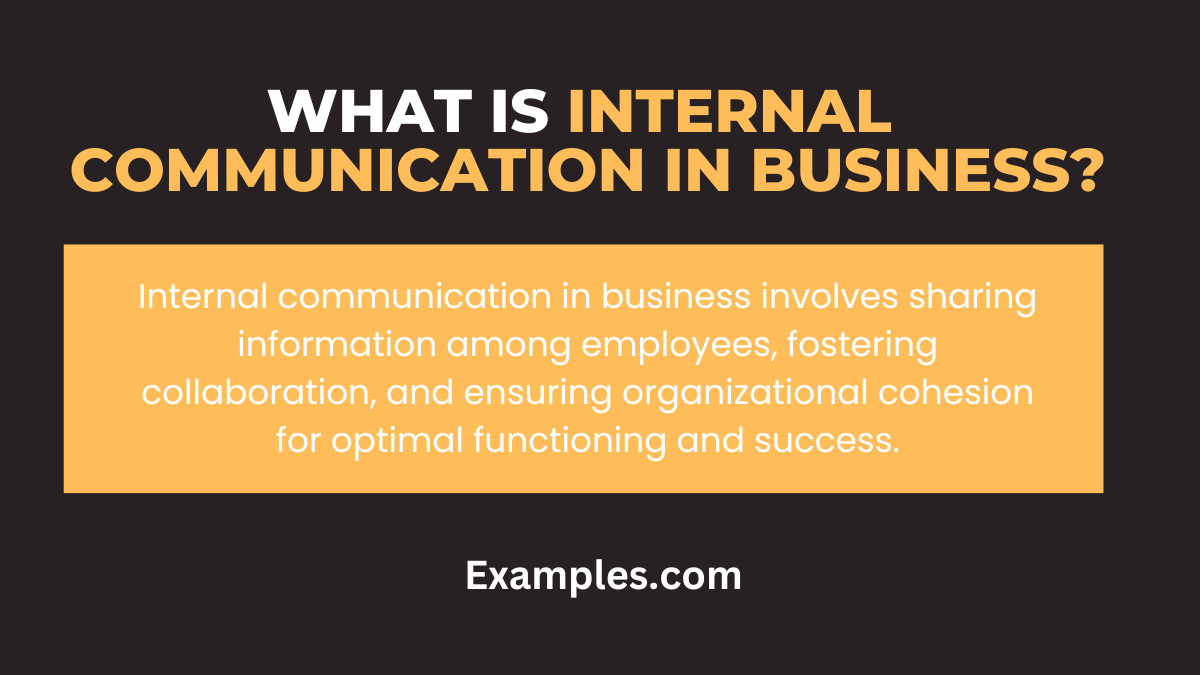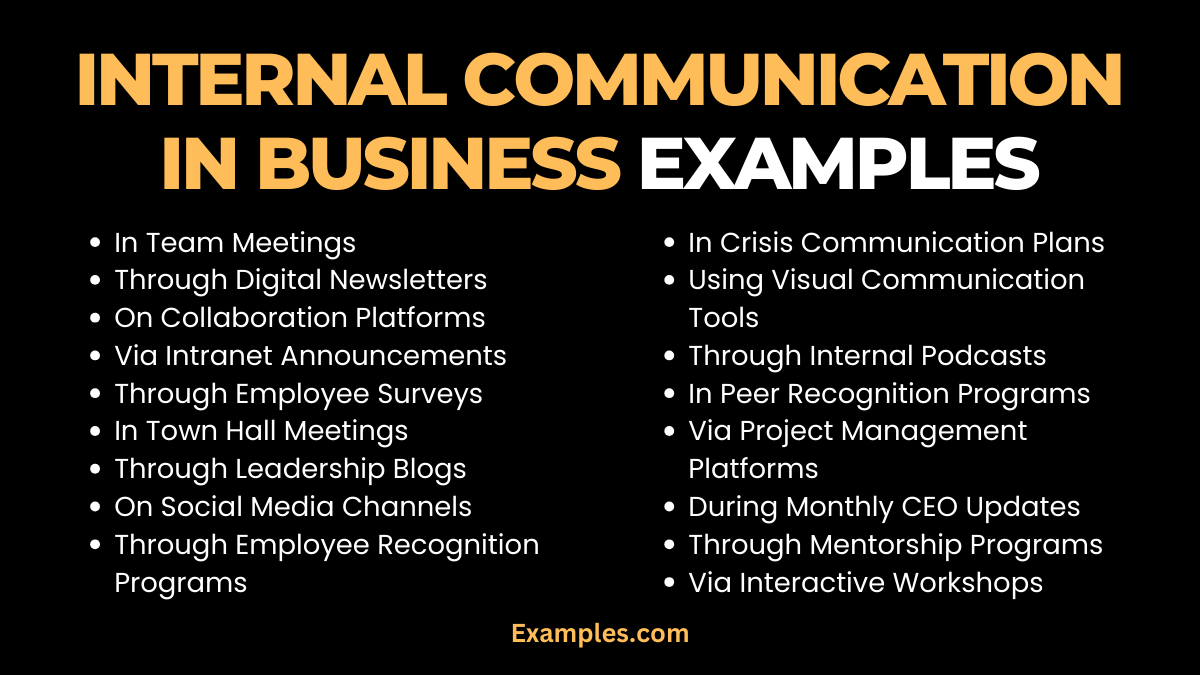19+ Internal Communication in Business Examples
Enhance workplace efficiency with our comprehensive guide on Internal Communication in Business. From effective strategies to real-world Communication Examples, we provide insights to foster seamless collaboration. Learn how to navigate the dynamics of business communication, ensuring clarity and synergy. Elevate your team’s performance by mastering the art of Internal Communication. Discover actionable tips and proven methods to create a communicative environment that fuels success. Read on for a transformative approach to business communication.
What is Internal Communication in Business?

Internal Communication in Business refers to the exchange of information, ideas, and feedback among individuals within an organization. It is the lifeblood that sustains a collaborative and well-functioning workplace. In simple terms, it involves how people within a company interact, share insights, and coordinate efforts. This H2 heading delves into the clear meaning and definition of Internal Communication, unraveling its significance in fostering effective teamwork and organizational success.
What is the best Example of Internal Communication in Business?
In the realm of business, an exemplary instance of Internal Communication revolves around the implementation of a company-wide intranet platform. This H2 heading explores this best practice in detail. Imagine a centralized digital hub accessible to all employees, facilitating seamless information sharing, collaboration, and updates. From departmental announcements to project progress, the intranet streamlines communication, enhancing transparency and fostering a cohesive work environment. Unravel the intricacies of this stellar example, showcasing the transformative power of effective Internal Communication in business.
20 Internal Communication in Business Examples

Explore 20 exemplary instances of internal communication in business that optimize information flow and promote organizational synergy. From traditional methods to digital platforms, these instances showcase effective ways to enhance communication within your workplace.
- In Team Meetings:
- Illustration: During team meetings, encourage open dialogue to ensure all members contribute their insights for more robust decision-making.
- Through Digital Newsletters:
- Illustration: Create engaging digital newsletters to keep employees informed about company updates, fostering a sense of unity and transparency.
- On Collaboration Platforms:
- Illustration: Utilize Slack for real-time information exchange, enhancing team collaboration and project efficiency.
- Via Intranet Announcements:
- Illustration: Leverage your company’s intranet for important announcements, ensuring a standardized and authoritative dissemination of information.
- Through Employee Surveys:
- Illustration: Implement regular surveys to create a structured feedback loop, providing valuable insights for continuous improvement in communication strategies.
- In Town Hall Meetings:
- Illustration: Hold quarterly meetings to allow leadership to address the entire organization, promoting transparency and open communication.
- Through Leadership Blogs:
- Illustration: Leadership blogs create a personal connection, allowing leaders to share insights, vision, and updates with the entire organization.
- On Social Media Channels:
- Illustration: Leverage social media for internal communication, creating a dynamic and interactive space for employees to engage and share ideas.
- Through Employee Recognition Programs:
- Illustration: Establish programs to celebrate achievements, boosting morale and motivation across the organization.
- During Cross-Departmental Huddles:
- Illustration: Conduct regular huddles between different departments to break down silos and encourage open communication among employees at all levels.
- In Crisis Communication Plans:
- Illustration: Implement a clear communication plan during crises to provide timely updates and reassure employees, fostering trust and transparency.
- Using Visual Communication Tools:
- Illustration: Leverage infographics to convey complex information in a clear and easily digestible manner.
- Through Internal Podcasts:
- Illustration: Create podcasts to share insights, updates, and success stories, offering a convenient and engaging medium for communication.
- In Peer Recognition Programs:
- Illustration: Encourage peer-to-peer recognition, allowing employees to acknowledge and appreciate each other’s contributions.
- Via Project Management Platforms:
- Illustration: Use Trello to streamline communication, ensuring tasks are assigned and progress is tracked collaboratively.
- During Monthly CEO Updates:
- Illustration: Provide monthly updates from the CEO to keep employees informed about high-level strategies, fostering a sense of alignment and transparency.
- Through Mentorship Programs:
- Illustration: Implement mentorship programs to facilitate communication between experienced and new employees, promoting knowledge transfer and collaboration.
- Via Interactive Workshops:
- Illustration: Conduct workshops on effective communication to equip employees with the skills and tools needed for successful collaboration.
- In Recognition Emails:
- Illustration: Send emails to individuals or teams for exceptional performance, reinforcing a positive and appreciative work culture.
- Through Employee Resource Portals:
- Illustration: Establish resource portals for easy access to important documents, policies, and updates, ensuring information is readily available and accessible
Internal Communication in Business Environment
Uncover the nuances of Internal Communication in the business environment. This essential guide explores strategies tailored to the workplace’s unique dynamics, ensuring seamless information flow and collaboration. Learn how effective communication within the organizational ecosystem propels success.
- Project Updates Forum: Establish a digital space for teams to share project progress and updates, fostering transparency and collective awareness.
- Virtual Brainstorming Sessions: Conduct interactive online sessions to ideate and innovate collaboratively, transcending geographical barriers.
Internal Communication in Business Management
Delve into the intricacies of Internal Communication in business management, a critical aspect of orchestrating cohesive operations. Explore strategies and techniques that empower managers to lead teams effectively through streamlined communication.
- Daily Stand-Up Meetings: Implement concise daily meetings for teams to share updates, address challenges, and align goals, enhancing managerial oversight.
- Employee Feedback Surveys: Utilize regular surveys to gather insights, enabling proactive management responses and continuous improvement.
Advantages of Internal Communication in Business
Unlock seamless communication within your organization. From heightened collaboration to improved employee engagement, effective internal communication strategies propel your business.
- Enhanced Team Collaboration:
- Example: Open dialogue and tools like Slack in project meetings foster real-time information exchange, boosting teamwork.
- Improved Decision-Making:
- Example: Regular team briefings ensure everyone is informed, contributing to more effective decision-making.
- Increased Employee Morale:
- Example: Appreciating achievements through a company-wide newsletter boosts morale and motivation.
- Efficient Problem Resolution:
- Example: Using a designated channel for issue reporting facilitates swift resolution, preventing escalation.
- Strategic Goal Alignment:
- Example: Regular communication on organizational goals fosters a collective effort toward shared objectives.
Types of Internal Communication in Business

Uncover the diverse landscape of internal communication, each type serving a unique purpose, optimizing information flow and enhancing synergy.
- Formal Channels:
- Example: Corporate memos articulate policies, ensuring standardized and authoritative dissemination of information.
- Informal Networks:
- Example: Watercooler chats foster organic information exchange among team members, creating a relaxed environment.
- Digital Platforms:
- Example: Utilizing platforms like Microsoft Teams for virtual meetings ensures efficient communication, especially in remote work settings.
- Vertical Communication:
- Example: In team briefings, leaders share information directly with subordinates, maintaining a clear hierarchy and alignment.
- Horizontal Communication:
- Example: Cross-functional collaboration in project groups breaks down silos, encouraging open communication among peers.
- Feedback Mechanisms:
- Example: Employee surveys create a structured feedback loop, providing insights for continuous improvement in communication.
- Team Huddles:
- Example: Daily stand-up meetings foster real-time information exchange, keeping team members aligned on project progress.
- Newsletters and Bulletins:
- Example: Weekly updates through newsletters keep everyone informed and connected to the organization’s happenings.
- Town Hall Meetings:
- Example: Quarterly town hall meetings allow leadership to address the entire organization, promoting transparency and open communication.
- Task Management Platforms:
- Example: Using tools like Trello for project management streamlines communication, ensuring clear task assignments and collaborative progress tracking.
Why is Internal Communication Important for Your Business?
Internal Communication is the linchpin of business success, offering an array of crucial advantages:
- Enhanced Team Collaboration:
- Fosters collaboration, ensuring teams work seamlessly towards shared goals.
- Improved Employee Morale:
- Boosts morale by keeping employees informed and valued.
- Increased Productivity:
- Reduces misunderstandings, enhancing overall efficiency and productivity.
- Transparent Leadership:
- Facilitates transparent leadership, building trust and a positive culture.
- Swift Problem Resolution:
- Empowers quick issue reporting and resolution, preventing escalation.
- Strategic Goal Alignment:
- Ensures all employees align with the company’s strategic objectives.
- Innovation and Idea Sharing:
- Encourages creativity through open communication and idea sharing.
- Adaptation to Change:
- Aids smooth transitions during organizational changes through clear communication.
- Employee Development:
- Provides opportunities for professional growth and skill enhancement.
- Positive Organizational Culture:
- Cultivates a positive work environment, fostering employee connection and support.
In conclusion, mastering internal communication is vital for fostering a collaborative and successful business environment. This comprehensive guide, accompanied by diverse examples, provides actionable insights to optimize information flow. Implementing effective internal communication strategies is the key to achieving organizational synergy and ensuring sustained success in today’s dynamic business landscape. Elevate your communication approach for a thriving workplace.



